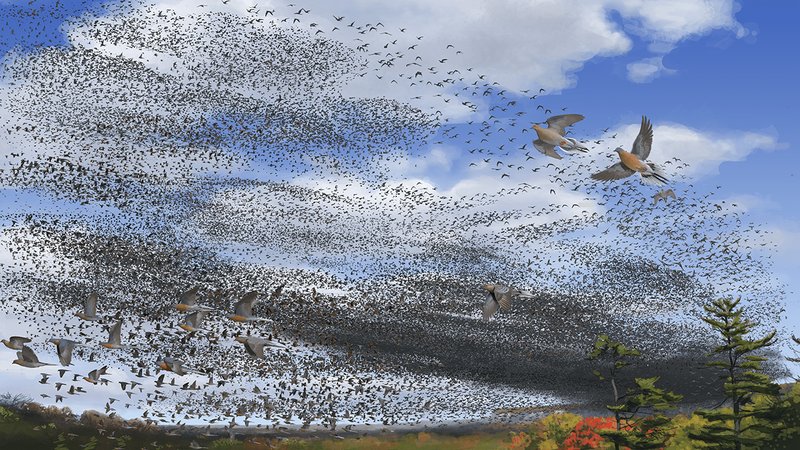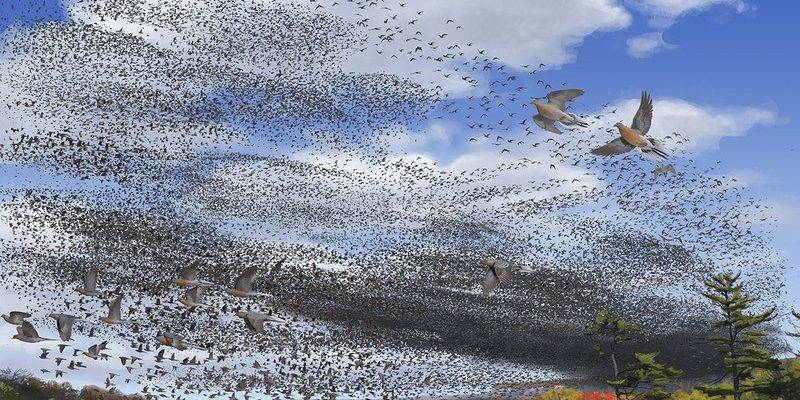
So, what made these birds so special? The passenger pigeon’s flying techniques were not just about grace; they were finely tuned survival strategies that allowed them to thrive in a changing world. Let’s explore how they flew, hunted, and ultimately became a symbol of what can happen when nature’s harmony is disrupted.
The Irresistible Flock: A Bird of Many Voices
Imagine standing in a forest, and suddenly, a loud roar fills the air. That was the sound of a passenger pigeon flock. These birds were known for their remarkable vocalizations. They communicated through a series of coos, whistles, and grunts that could echo across miles. This created a sense of unity and coordination within the flock. As they traveled, each sound helped maintain their formation, allowing them to stay together even in vast numbers.
You might be wondering, why is this important? Well, living in such large groups provided safety from predators. When you have hundreds or thousands of birds flying together, it’s harder for a hawk or other hungry predators to pick off an individual. The sheer size of the flock could confuse and deter threats, giving the passenger pigeons another layer of protection.
Their group dynamics didn’t just affect their survival; it also played a crucial role in their hunting techniques. By coordinating their movements, they could cover large areas while foraging for food, making sure each bird benefited from the collective effort.
Mastering the Skies: Agile Flight Patterns
One of the most impressive things about the passenger pigeon was its agility in flight. These birds could reach speeds of up to 60 miles per hour! Picture a sports car zipping down the highway—quick, sleek, and with precision handling. That’s how the passenger pigeon navigated the sky. Their pointed wings and streamlined bodies allowed them to make sharp turns and quick dives, evading predators and swooping in to grab food.
Passenger pigeons often flew in a loose, undulating pattern. It wasn’t just for style; this method helped them conserve energy while traveling long distances. They could glide on air currents, making flight more efficient. So instead of flapping away endlessly, they knew how to ride the winds.
This flight skill was especially handy during migration. In the autumn, they would travel south in search of warmer weather and food, demonstrating incredible navigation skills along the way. They relied on landmarks and perhaps even the stars, allowing them to find their way through vast and unfamiliar landscapes.
Feeding Frenzy: Group Hunting Techniques
Now, let’s talk about how these birds actually found food. Passenger pigeons were primarily seed-eaters. They had a special fondness for acorns, beechnuts, and various seeds. Because they traveled in groups, finding food was a collective effort. While some birds foraged on the ground, others kept watch for potential threats. This collaborative approach increased their chances of finding plenty to eat while minimizing individual risk.
Here’s a fun fact: when they found a food source, the flock would descend upon it voraciously. You could call it a feeding frenzy! Hundreds, even thousands of pigeons would feast together, creating an awe-inspiring sight. With so many birds eating in one place, they could strip trees and the forest floor bare within hours.
But here’s the catch: Their dependence on specific food sources made them vulnerable. If acorn crops failed or habitat changed, the consequences for the passenger pigeon could be dire. It highlights the fragility of ecosystems and how interconnected the survival of a species can be.
Adaptability and Environmental Awareness
Honestly, the passenger pigeon’s ability to adapt was impressive. They thrived in diverse environments, from dense forests to open fields. Their keen awareness of their surroundings helped them respond to changes in the environment. When a forest cleared or a new food source became available, they quickly adjusted their foraging and flying patterns.
One example of this adaptability can be seen in their nesting habits. They often nested in large colonies, sharing trees with hundreds of other pigeons. This communal nesting approach offered safety in numbers and made it easier to raise chicks. The sheer volume of their nests could create a beautiful tapestry across the treetops—a sight that must have been breathtaking.
However, this adaptability also had a downside. As human development expanded into their habitats, passenger pigeons faced new challenges. Deforestation and agricultural expansion reduced their living space and food availability. It’s a classic case of nature versus human progress and serves as an important lesson about respecting and preserving the natural world.
The Passenger Pigeon’s Legacy
Sadly, the passenger pigeon’s incredible abilities couldn’t protect it from extinction. By the early 20th century, overhunting and habitat loss had taken their toll. What was once a flourishing population of billions dwindled to just a few remaining individuals. The last known passenger pigeon, named Martha, died in captivity in 1914.
Their story is a tough one to swallow. However, it also serves as a vital reminder of the importance of conservation. When we think about how unique and adaptable the passenger pigeon was, it’s hard not to feel a sense of loss. They were more than just birds; they were a part of our ecosystem. Their extinction highlighted the dire consequences of unchecked human activity.
While we may never see these stunning birds in the sky again, the lessons they teach us about preservation and respect for nature live on. We can honor their memory by advocating for wildlife conservation and working to protect the ecosystems that still exist.
So, what can we take away from the story of the passenger pigeon? Their incredible flying and hunting techniques remind us of the beauty and complexity of nature. These birds were not just a part of the ecosystem; they were a vital force within it. By understanding their unique abilities and tragic fate, we can better appreciate the delicate balance of life and the importance of protecting our environment for future generations.
As we look to the skies, let’s remember the passenger pigeon and all they represented. The world is full of wonders waiting to be explored, and every creature has a role to play. By taking steps to safeguard wildlife and their habitats, we can ensure that future generations will have their own breathtaking stories to tell.

